Are garden cultivars of Maiden Grass truly sterile and safe to plant?
Chinese Silver Grass, Maiden Grass, Zebra Grass, Eulalia - Miscanthus
 Miscanthus sinensis 'Zebrinus' Image by Mark Martins from PixabayGarden cultivars of Miscanthus, like ‘Variegatus and ‘Zebrinus’, are considered to be sterile and therefore safe to plant in gardens. To test that theory, scientists put the plants to the test. Read about their conclusions below, and if you still want to grow them you can, as they are not classified as invasive in SA.
Miscanthus sinensis 'Zebrinus' Image by Mark Martins from PixabayGarden cultivars of Miscanthus, like ‘Variegatus and ‘Zebrinus’, are considered to be sterile and therefore safe to plant in gardens. To test that theory, scientists put the plants to the test. Read about their conclusions below, and if you still want to grow them you can, as they are not classified as invasive in SA.
Condensed Version:
Miscanthus form tall and broad grassy clumps of elegant ribbon-like leaves that arch outward with a fountain-like habit. Tall reed-like flowering stems carry the beautiful plumes of flowers, followed by lovely fluffy seeds to provide an airy distraction in the garden. Depending on where these perennials are grown, they can be evergreen, but are generally dormant in winter, especially in severely cold regions, but they will sprout again in spring with great vigour.
Ideal conditions for miscanthus are moderately fertile, and moist but well-drained soil, in full sun. They will tolerate semi-shade but in too much shade they will lose their bright colours. Although drought tolerant, in hot and dry summer regions they will need moderate watering to keep them looking at their best in the garden, and in the winter rainfall regions the plants will need to be protected from being excessively wet in winter. The plants do well in coastal gardens, but will not tolerate direct maritime exposure. They are hardy to cold and frost and in cold regions they become completely dormant in winter, enabling them to tolerate very low temperatures.
When planting these grasses, give them sufficient space to develop and remember that they take 5 years to reach maturity. Prepare the beds by adding lots of compost, especially in very poor soils, and fertilise with compost or good organic plant food annually in spring.
If you like the look of the dry feathery flowers for winter scenes, leave them on the plants, then shear the stalks right down to ground level in late winter or spring.
Full Version:
Description, History & Interesting Facts:
Miscanthus sinensis ‘Variegatus’ and ‘Zebrinus’ are garden cultivars of Miscanthus sinensis that have become extremely popular ornamentals worldwide, for good reasons. They form tall and broad grassy clumps of elegant ribbon-like leaves that arch outward with a fountain-like habit. Tall reed-like flowering stems carry the beautiful plumes of flowers, followed by lovely fluffy seeds to provide an airy distraction in the garden. Depending on where these perennials are grown, they can be evergreen, but are generally dormant in winter, especially in severely cold regions, but they will sprout again in spring with great vigour.
The name Miscanthus was given to this genus of perennial grasses by the 19th century Swedish botanist Nils Johan Andersson. It comes from the Greek words 'miskos' which means "stem" or "stalk" and 'anthos', meaning "flowers" in reference to the seed heads having stalked spikelets.
 Miscanthus sinensis Picture courtesy Matt Lavin from flickrMiscanthus sinensis, the ancestor or our garden cultivars, is commonly called “Chinese Silver Grass”, “Maiden Grass”, “Zebra Grass”, or “Eulalia” and is a member of the grass family, Poaceae. It is native to China, Japan, South Korea, and Taiwan where it thrives as an herbaceous perennial, growing anything from 80cm to 2m tall, forming dense, grassy clumps of foliage from an underground rhizome.
Miscanthus sinensis Picture courtesy Matt Lavin from flickrMiscanthus sinensis, the ancestor or our garden cultivars, is commonly called “Chinese Silver Grass”, “Maiden Grass”, “Zebra Grass”, or “Eulalia” and is a member of the grass family, Poaceae. It is native to China, Japan, South Korea, and Taiwan where it thrives as an herbaceous perennial, growing anything from 80cm to 2m tall, forming dense, grassy clumps of foliage from an underground rhizome.
Each leaf is sparsely pubescent on both sides with sharp and slightly serrated (rough) margins. Blades are green to variegated, with whitish collars. The pale-pink to reddish flowers appear in terminal panicles, 10 to 35cm long, held on stalks that can reach 3m. It not only spreads via rhizomes, but also by windborne seeds produced in autumn. In winter the plant becomes dormant and new growth emerges by mid-spring, replacing the previous year’s dried leaves.
Miscanthus sinensis in its original species form became immensely popular in western gardens about a century ago because of the powerful structure and year-round interest it added to landscapes, and today there are over 100 known cultivars, including those used for biofuel and paper pulp. Sadly Miscanthus sinensis has become an invasive plant in many countries, and in the USA it is listed as invasive in 25 states, the District of Columbia, and Ontario.
Garden cultivars of Miscanthus like ‘Variegatus and ‘Zebrinus’, are considered to be sterile and therefore safe to plant in gardens. They are also the easiest varieties to find in garden centres in South Africa.
Silver Maiden Grass (Miscanthus sinensis ‘Variegatus’) is a popular antique variety that has been used in gardens since the 1900’s. It forms a beautiful clump over 1m tall and about 2m wide and its arching ribbon-shaped leaves have rich cream-colored stripes running along the length of the deep green foliage, giving this plant a white appearance from a distance.
This grass requires a very long, hot growing season to be able to produce flowers. When it does, the tassel-like plumes rise above the foliage in early autumn and open with strong red tints, and as the seeds mature, they become fluffy, and persist well into winter, providing good winter interest, and a great accent to the foliage which fades to a tan colour after the first winter frosts.
In warmer climates this plant can become quite weedy.
Miscanthus sinensis ‘Zebrinus’ must be counted as one of the most spectacular and captivating garden plants with its long arching leaves and appealing stripes across their width, giving them the look of dappled foliage in the sunlight. Once mature, the dense grassy foliage can reach spectacular heights up to 1.5m or more, with an equal spread, to produce a wonderful screen or specimen plant. The plant is deciduous, and the brand new spring leaves are a deep green, only showing more and more golden striping as the leaf matures. Its lovely fluffy autumn seeds contrast wonderfully with the late autumn foliage.
Depending on where you live, zebra grass can be an invasive plant, like many other alien plants that spread by means of underground rhizomes. It is considered an invasive species in parts of the U.S.A. in National Parks in North Carolina, Tennessee, Washington D.C., and Virginia.
Miscanthus sinensis var. condensatus ‘Cabaret’ is a tall, clump-forming grass over 1m tall and about 2m wide, but it can reach nearly 2.5m high once mature. The dark green leaves are up to 32mm wide and have a broad central creamy-white stripe. In autumn the reed-like flowering stems produce coppery-pink flower-heads that turn cream and silver as they mature.
To test the theory that garden cultivars are sterile and not a threat, scientists at the Chicago Botanic Garden conducted invasive-species trials, which ran for four years from 2006 through 2010. Thirty four Miscanthus varieties were grown, each in their own separate trial beds, and many aspects of their growth was monitored, including their vigour, bloom period, and flower production. In a short time the scientists observed an increasing number of seedlings carpeting the trial plots and adjacent landscapes each spring, despite them being quarantined.
Inflorescences from each of the 34 plants were also X-rayed to see if embryos were present in the seeds, and to assess the quality and the quantity of viable seed. The results were surprising, and the number of viable seeds per plant varied widely, from as few as 497 in the variety called ‘Dixieland’ to a staggering 349,327 in ‘Kleine Silberspinne’.
The study revealed that seed production and viability varied significantly among cultivars. Only ‘Hinjo’ and ‘Silberpfeil’, ‘Cabaret’ (M. sinensis var. condensatus ‘Cabaret’), and giant miscanthus (M. × giganteus) produced no viable seed.
In South Africa the two most common maiden grasses grown ornamentally, ‘Variegatus’ and ‘Zebrinus’, were included in the tests and here are the results of the viability of each cultivar’s seed. ‘Little Zebra’ produced 2,704 viable seeds per plant, and ‘Variegatus’ 211 seeds per plant.
Scientists concluded that many cultivars touted as “sterile” were, in fact, not sterile. And because many of the less-fertile cultivars were late flowering varieties, this may indicate that they did not have a long enough growing season to complete seed production, so they advise gardeners to be cautious. These trials demonstrate the importance of evaluating all cultivars for their invasive potential.
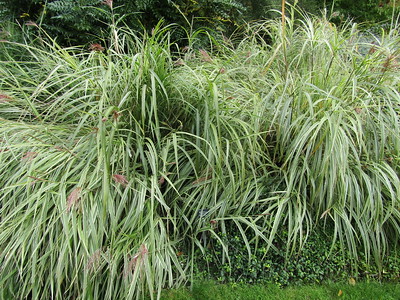 Miscanthus sinensis 'Variegatus' Picture courtesy Leonora (Ellie) Enking from flickrIn the Garden:
Miscanthus sinensis 'Variegatus' Picture courtesy Leonora (Ellie) Enking from flickrIn the Garden:
‘Variegatus’ and ‘Zebrinus’ are not listed as invasive in South Africa, but I urge gardeners to monitor these plants in their own gardens for invasiveness, and to remove them if they do show signs of bearing fertile seeds which the birds will spread far and wide. This is especially important if you live within, or in close proximity to green belts.
Miscanthus brings movement into the landscape, and their dramatic foliage and plumes makes them great accent plants and a pretty backdrop for a mixed border. They demand attention if planted in groups and are used as fillers for a tropical looking garden.
‘Variegatus’, ‘Zebrinus’ and ‘Cabaret’ are wonderful close to water features where their lovely wavy plumes take centre stage, or in grassland or meadow gardens; together with other ornamental grasses. They are also often used to bind the soil on banks, and their clumping habit lends itself to the creation of small informal screens or hedges. Their lovely form is striking enough, even when they are planted alone in a container.
The foliage of Miscanthus ‘Zebrinus’ and ‘Cabaret’ last long in a vase and is grown commercially for the cut flower trade.
South Africa boasts several beautiful indigenous grass species that are used by landscapers, so if you are concerned, please do some research online to find indigenous nurseries in your area. They will give you the right advice and alternatives suitable for your region. Some may not be quite as showy as the exotic species, but the peace of mind they bring with the knowledge that you are supporting our local wildlife and especially our indigenous birds, who not only rely on grasses as a food source, but also for nesting material, far outweighs the fact that they may not be considered as pretty, and the joy of attracting birds to the garden is the true reward of planting indigenous grasses.
Cultivation/Propagation:
Ideal conditions for miscanthus are moderately fertile, and moist but well-drained soil, in full sun. They will tolerate semi-shade but in too much shade they will lose their bright colours.
Although drought tolerant, in hot and dry summer regions they will need moderate watering to keep them looking at their best in the garden, and in the winter rainfall regions the plants will need to be protected from being excessively wet in winter. The plants do well in coastal gardens, but will not tolerate direct maritime exposure.
They are hardy to cold and frost and in cold regions they become completely dormant in winter, enabling them to tolerate very low temperatures. ‘Variegatus’ is known to tolerate temperatures as low as -12°C.
When planting these grasses, give them sufficient space to develop and remember that they take 5 years to reach maturity. Prepare the beds by adding lots of compost, especially in very poor soils, and fertilise with compost or good organic plant food annually in spring.
If you like the look of the dry feathery flowers for winter scenes, leave them until spring rather than cutting them out. The dead stalks also act as a bit of mulch to protect the root system from winter's chilling temperatures. If you prefer to cut the stalks early in winter, leave about 15cm sticking up, and only trimming them away in late winter or early spring. A much simpler approach is to wait until late winter or early spring and then shear the stalks right down to ground level.
Problems, Pests & Diseases:
No serious pests are normally seen on the plants but they may succumb to leaf damage from chewing insects, aphids and spider mites
In warm and humid regions Anthracnose may become a problem, and preventative spraying against fungal diseases may be necessary. Anthracnose is a term used to loosely describe a group of related fungal diseases that typically cause dark lesions on leaves. In severe cases it may also cause sunken lesions and cankers on twigs and stems.
Rust diseases occasionally infest the foliage but it often goes away on its own in drier weather.
Warning:
Miscanthus 'Zebrinus' has no toxic effects reported for people, dogs, cats, horses or livestock.
Go wild with these gorgeous indigenous grasses!
Daba Grass, Ruigtegras, Umpumelelo, Broom Grass - Miscanthus
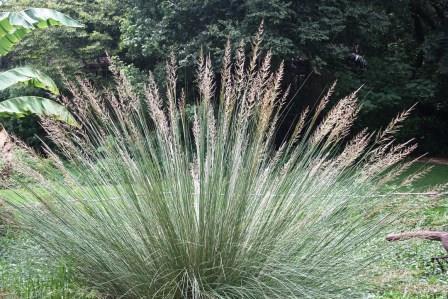 Miscanthus junceus at Walter Sisulu National Botanical Garden. Picture courtesy Random Harvest NurseryCondensed Version:
Miscanthus junceus at Walter Sisulu National Botanical Garden. Picture courtesy Random Harvest NurseryCondensed Version:
These grasses are hardy to cold and frost and very wind tolerant, plus they are easy to grow in damp or normal garden conditions, and will adapt to most garden soils. They love full sun but will take some light shade, and to keep them looking at their best in the garden, water moderately during long, dry spells. Fertilising can simply be applying a fresh layer of organic mulch around the roots occasionally. As with all grasses, to keep them healthy, cut them right back once a year and rake to remove the thatch. Mulch the soil and give the plant a thorough watering and in no time, fresh new leaves will shoot.
For planting up smaller areas plants can be purchased from indigenous nurseries, and for large areas seed can be sown directly into prepared beds in spring or autumn.
Full Version:
Description, History & Interesting Facts:
Ornamental grasses add an extra dimension to the garden as they whisper and wave in the breeze - all it takes is a gust of wind to bring the garden to life. They also bring life to the garden in the form of birds, butterflies, moths, and other wildlife. Grasses are also extremely low maintenance and it’s no wonder they’ve become so popular in recent years.
I would like to thank Random Harvest for letting me use their beautiful photographs of these grasses. Click here to visit their website.
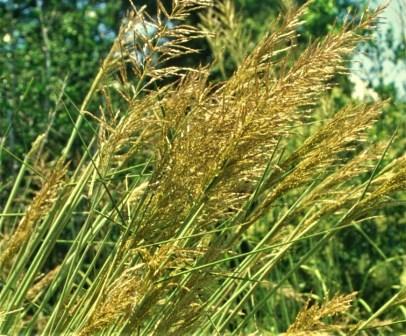 Miscanthus capensis seeds. Picture courtesy Random Harvest NurseryDaba Grass, Ruigtegras, Umpumelelo ( Miscanthus capensis)
Miscanthus capensis seeds. Picture courtesy Random Harvest NurseryDaba Grass, Ruigtegras, Umpumelelo ( Miscanthus capensis)
Miscanthus capensis is a very hardy, clump-forming evergreen grass of medium height that is commonly called "Daba Grass", "Ruigtegras", and "Umpumelelo". The clumps of bright green grassy leaves are about 1m tall, but in late summer and early autumn when the pale to reddish-brown flower spikes appear, topped with plumes of tall and elegant pinkish-coloured seed-heads, they can reach up to 2m in height.
Miscanthus capensis is extensively dispersed in South Africa growing wild in the Free State, KwaZulu-Natal, Eastern Cape, Northern Cape and Western Cape. It can be found in bushveld, grasslands, and along forest margins and the banks of rivers and streams.
Miscanthus capensis is an integral part of our fynbos and one of the grasses of Table Mountain. It thrives in moist areas and is also a grass of the Drakensberg wetlands. In the uKhahlamba Drakensberg Park (formerly Natal Drakensberg Park) it occurs at altitudes of 1 400 to 2 200m, on various types of loamy soils, favouring grasslands with temporary seasonal wetness, like floodplains, valley-heads, and foot-slope seepages.
The uKhahlamba Drakensberg Park was designated as a Ramsar site on 21 January 1997, and features 242,813ha of high altitude tarns, springs, bogs, marshes and streams. The area is located in eastern KwaZulu-Natal, along the border between KwaZulu-Natal and the Kingdom of Lesotho. These high altitude wetlands are amongst the most species-rich in South Africa and they house a number of rare plant species.
A Ramsar site, also known as "The Convention on Wetlands", is a wetland site designated to be of international importance under the Ramsar Convention, an intergovernmental environmental treaty established in February 1971 by UNESCO, in Ramsar, Iran, and came into force in December 1975. Ramsar identifies wetlands of international importance, especially those providing waterfowl habitat, and provides international cooperation regarding the conservation of these wetlands, and the sustainable use of their resources
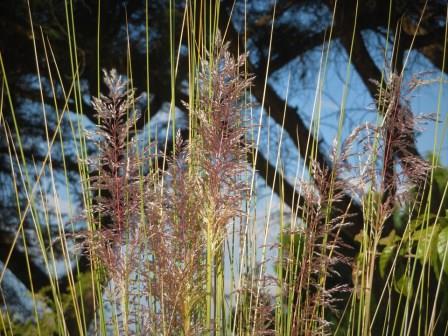 Miscanthus junceus flower heads. Picture courtesy Random Harvest NurseryBroom Grass, Besemgras (Miscanthus junceus)
Miscanthus junceus flower heads. Picture courtesy Random Harvest NurseryBroom Grass, Besemgras (Miscanthus junceus)
Miscanthus junceus is a tall, very fast growing and hardy evergreen grass with furry, grey, rush-like foliage in stiff upright clumps 1 to 1.5m high. It bears long elegant plumes of flower heads with tiny brown flowers from February to June.
It can be found in the Eastern Cape, Gauteng, KwaZulu-Natal, Limpopo, Mpumalanga, and North West Gauteng. It always occurs in or near water, on riverbanks or in vleis, and mostly in coarse sandy soils at 700 to 1 400m altitude. It is ideally suited to stabilising river banks and plays a role in water purification.
In the Okavango delta it is the most common grass in permanent water, and is also called "Okavanga Delta Grass". Also, in Mpumalanga, it is dominant in shallow-water vegetation. The species plays an important role in riverbank protection and water purification.
Uses:
The roots of Miscanthus junceus assists in filtering out pollutants and dirt, and can be used to purify water by running it through beds of this grass.
Miscanthus capensis is a coarse grass that is often used for thatching, and traditionally, the root decoction of the plant has been reported to treat pimples, wounds, eczema, and acne. Studies using root methanol extract have demonstrated that the plant extract shows strong antioxidant and non-genotoxic activities.
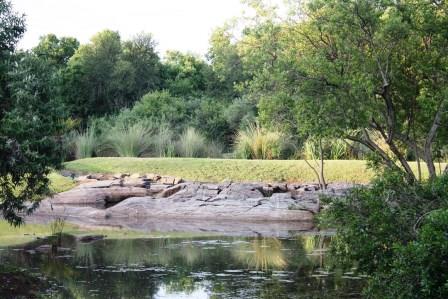 Miscanthus junceus in Patrick Watson landscape design. Picture courtesy Random Harvest NurseryIn the Garden:
Miscanthus junceus in Patrick Watson landscape design. Picture courtesy Random Harvest NurseryIn the Garden:
Ornamental grasses add texture and an extra dimension to the garden as they whisper and wave in the breeze- all it takes is a gust of wind to bring the garden to life. They also bring life to the garden in the form of birds, butterflies, moths, and other wildlife. Weavers choose Miscanthus capensis grass above all other plants for their nesting material, weaving the leaves and then lining the nest with the seeds. Seed-eating birds in particular will flock to the garden in autumn when the grasses go to seed. Butterflies also need grasses as host plants for their larvae, and African moths like Acrapex albivena are also known to use Miscanthus capensis as a larval food plant.
Click here to see Google images of these African moths.
Click here to see Google images of weavers and their nests
Miscanthus is ideally suited to stabilising river banks, and perfect to plant on the edge, or even in a pond.
Grasses have become extremely popular in modern city gardens because, not only are they beautiful but also almost maintenance free. Use them as a backdrop to a garden bed or as a screening plant in narrow beds. Miscanthus is very effective planted as a single, sculptural, feature plant in a garden, and is just as striking if planted into large window boxes or other containers, where they can be used as a hardy and wind tolerant screen on a balcony or rooftop garden.
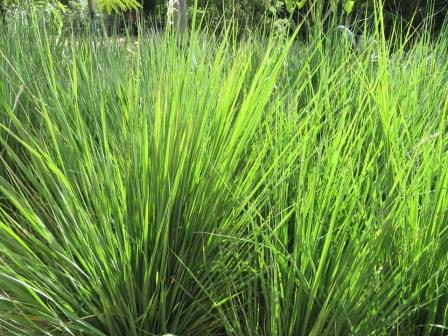 Miscanthus capensis. Picture courtesy Random Harvest NurseryCultivation/Propagation:
Miscanthus capensis. Picture courtesy Random Harvest NurseryCultivation/Propagation:
These grasses are hardy to cold and frost and are also very wind tolerant, plus they are easy to grow in damp or normal garden conditions, and will adapt to most garden soils. They love full sun but will take some light shade, and to keep them looking at their best in the garden, water moderately during long, dry spells. Fertilising can simply be applying a fresh layer of organic mulch around the roots occasionally. As with all grasses, to keep them healthy, cut them right back once a year and rake to remove the thatch. Mulch the soil and give the plant a thorough watering and in no time, fresh new leaves will shoot.
For planting up smaller areas plants can be purchased from indigenous nurseries, and for large areas seed can be sown directly into prepared beds in spring or autumn.
For the best germination results with seeds it is recommended that they are treated with Cape Seed Primer.
Problems, Pests & Diseases:
If they are happy where they are sited, these grasses suffer from no problems, pests and diseases.
Warning:
We found no toxic effects reported for Miscanthus species, for people, dogs, cats, horses or livestock.
Why aren’t we all planting Oortjies in our gardens?
White Carpet, African Morning Glory, Creeping Falkia, Oortjies - Falkia repens
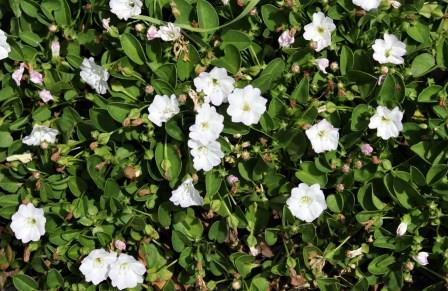 Falkia repens in bloom. Picture courtesy www.randomharvest.co.zaCondensed Version:
Falkia repens in bloom. Picture courtesy www.randomharvest.co.zaCondensed Version:
White carpet is an evergreen groundcover with small, shiny green to yellowish leaves that are slightly succulent, with rounded tips and bases. It spreads quickly by rooting from the nodes, and can spread 30 to 46cm to form a flat mat of foliage, only about 5 to 10cm in height. Paper-like flowers appear from spring to December. They are large and trumpet-shaped, opening a pale pink and fading to white.
This hardy evergreen can tolerate heat, drought, and poor soil, and will grow in both the winter and summer rainfall regions. It survives frost and temperatures as low as -1°C, and in regions where the temperatures fall way below zero, it will become totally dormant in winter, re-sprouting again in spring. It adapts to a wide range of soil conditions and will grow in poor soils, but thrives in more fertile, humus-rich, and well-drained soils.
White carpet it will grow in shade and in full sun as long as it gets lots of water. And, although drought tolerant, it looks its best if watered moderately. New plantings should be watered daily for a couple of weeks and the spacing between plants should be at least 30 to 46mm, as the plants spread fast. It responds well to an annual feeding in spring with organic 2:3:2 or 3:1:5 fertilisers and the plants can be mulched annually with compost.
Full Version:
Description, History & Interesting Facts:
This absolutely delightful little indigenous groundcover seems to be more popular overseas than it is in its home country – shame on us! South Africans really need to appreciate our own flora a lot more, and although things have changed a lot over the last 20 years or so, when indigenous plants were very hard to find in garden centres, except for the most showy ones, and today retail outlets are stocking a lot more South African plants, due to the increase in demand for them, we still have a long way too go.
It is good to bear in mind that any retail business is driven by demand, and logically garden centres will not stock a plant that does not sell well, but, as consumers we don’t always realise how much value our buying power has, so if you want a certain indigenous plant, ask at your local garden centre for it, and if they say they don’t stock it, tell them all about it and why you specifically want that plant, and that you want it so badly you are prepared to go to an indigenous nursery to get one. They will take note, and if they start getting lots of requests for the same plant, any good plant buyer will ensure that some are ordered just to see how well they do. I am convinced that if retailers have this little charmer on display when it is in full bloom, customers will find them irresistible!
Falkia repens is often called “White Carpet”, “African Morning Glory”, “Creeping Falkia”, or Oortjies. It is an evergreen perennial groundcover that belongs to the same family as morning glories (Convolvulaceae) which most South Africans know as terribly invasive. However, you don’t have to worry about Falkia repens as it is endemic to the Eastern and Western Cape, where it can commonly be found growing in damp or temporarily inundated soil alongside rivers and streams, in damp coastal flats and seeps, damp grasslands, and in vleis or along their margins.
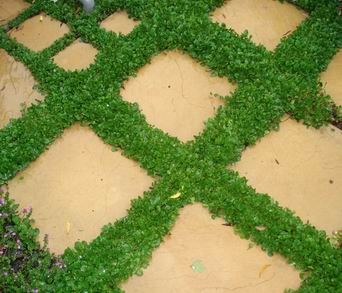 Falkia is great between pavers. Picture courtesy www.randomharvest.co.zaOortjies in Afrikaans means ‘little ears’ in reference to its small, shiny green to yellowish leaves that are generally broadly ovate and slightly succulent, with rounded tips and bases, looking rather like little ears. The plant spreads quickly by rooting from the nodes, and can spread 30 to 46cm to form a flat mat of foliage, only about 5 to 10cm in height.
Falkia is great between pavers. Picture courtesy www.randomharvest.co.zaOortjies in Afrikaans means ‘little ears’ in reference to its small, shiny green to yellowish leaves that are generally broadly ovate and slightly succulent, with rounded tips and bases, looking rather like little ears. The plant spreads quickly by rooting from the nodes, and can spread 30 to 46cm to form a flat mat of foliage, only about 5 to 10cm in height.
Nature is so incredible, and the way this little plant reproduces is fascinating! An abundance of delicate paper-like flowers that resemble miniature poppies appear from spring to December. They are large and trumpet-shaped, opening a pale pink and fading to white. The flowers are pollinated by moths and bees, and the fruits, are known as “schizocarps”. A schizocarp is a single dry fruit pod that, once fully mature will split into two or more separate carpels. The carpels are the female reproductive organs of a flower, consisting of an ovary, a stigma, and usually a style.
Once the flowers fade they bend over to penetrate the soil, where the fruit continues to mature beneath the surface of the ground, just like peanuts. This means of reproduction is called “geocarpy”, and is an extremely rare means of plant reproduction, in which plants that were pollinated above-ground produce diaspores within the soil. In botany, a diaspore is a plant dispersal unit consisting of a seed or spore plus any additional tissues that assist dispersal. This type of dispersal evolved as an effective means of ensuring a suitable environment for the plant's offspring.
In the Garden:
White carpet is a reliable groundcover for any location and suits all garden styles, tropical, woodland, country, cottage, or pebble and rock gardens. It is also a good candidate for roof gardens and to stabilise the soil on banks.
Because white carpet grows quickly and takes only around 1 year to reach maturity, it is great in solid stands, and works beautifully in combination plantings where it covers the ground fast to suppress weeds, and looks great all year round.
It remains low, making it an excellent choice to plant between stepping-stones, and even to replace lawn where there is little or no foot traffic. It’s just as effective flowing over rocks or walls, and most elegant cascading over pots and hanging baskets.
The flowers attract bees, moths, and other tiny insects to the garden that are useful to feed lizards and frogs.
 Falkia repens on pathway. Picture courtesy www.randomharvest.co.zaCultivation/Propagation:
Falkia repens on pathway. Picture courtesy www.randomharvest.co.zaCultivation/Propagation:
Despite its delicate appearance white carpet is a hardy evergreen that and can tolerate heat, drought, and poor soil.
It will grow in both the winter and summer rainfall regions of the country, and survives frost and temperatures as low as -1°C, and in regions where the temperatures fall way below zero, it will become totally dormant in winter, re-sprouting again in spring if the roots are mulched in autumn to protect them.
It is also adaptable to a wide range of soil conditions and will grow in poor soils, but thrives in more fertile, humus-rich, and well-drained soils, so adding some compost to the planting holes will benefit the plants.
Although many gardeners grow it in semi-shade, white carpet it will also grow happily in full sun as long as it gets lots of water. In too much shade the plant will grow taller. White carpet is drought tolerant, but to look at its best in the garden it requires moderate but regular watering, and it can be planted in quite wet areas, as well as in beds that will be irrigated along with the rest of the garden.
New plantings should be watered daily for a couple of weeks and the spacing between plants should be at least 30 to 46mm, as the plants spread fast.
White carpet respond well to an annual feeding in spring with organic 2:3:2 or 3:1:5 fertilisers to encourage new, lush growth and more flowers. The plants can also be mulched annually with compost.
Falkia is propagated from rooted runners by dividing sections of the plant with its roots. This can be done at any time but is generally done when the clumps are divided every 3 to 4 years. Dividing the clumps ensures renewed vigour and strong growth.
Pruning after flowering to remove all the flower stalks to the base of the plant will keep the plant's energy focused on vigorous new leaf growth instead of seed production. Cut the plants back hard any time they start to turn brown.
Problems, Pests & Diseases:
Falkia repens is seldom attacked by pests and diseases.
Warning:
I did not find Falkia repens listed as toxic for humans or pets, but I always advise the supervision of small children in the garden and that pets are discouraged from chewing on plants.
Oortjies, White Carpet, African Morning Glory - Falkia repens
Corsican mint forms a dense, soft mat of very low growing foliage
Rock Mint, Corsican Mint, Creeping Mint - Mentha requienii
 Mentha requienii. Image by Gerson Rodriguez from PixabayCondensed Version:
Mentha requienii. Image by Gerson Rodriguez from PixabayCondensed Version:
Because the leaves of Corsican mint are highly aromatic and the plant tolerates light foot traffic, it is often put to good effect by planting it between pavers or stepping stones, where its wonderful peppermint fragrance can be released underfoot.
Corsican mint grows well in South Africa and is a perennial that goes dormant in winter but may stay semi-evergreen in frost free regions. It tolerates light frosts without protection, and where hard frosts occur it will go totally dormant in winter, enabling it to tolerate very low temperatures. In severely cold regions the roots must be mulched in autumn to keep them from freezing. Dormant plants quickly re-sprout again in spring.
It thrives in semi-shade; and in full sun if it is watered regularly. In very hot summer regions it will appreciate some midday and early afternoon shade. Corsican mint adapts to most garden soils but grows best in rich, light, moist but well-drained soils. It will not do well in dry soils. To thrive, all mints need to be watered regularly, and are intolerant of drought.
This plant is a light feeder, so avoid over fertilising. An annual feed in spring using a balanced, water-soluble fertiliser should suffice to keep it healthy. Mint plants requires plenty of air circulation, so thin out the plants regularly to avoid overcrowding, and to keep them low and compact, cut the plants right back after flowering.
Full Version:
Description, History & Interesting Facts:
Corsican mint is one of the smallest members of the mint family, and an old garden favourite because it creeps continually to form a beautiful, dense and soft mat of very low growing foliage, generally growing only about 1 to 5cm tall. However, under perfect conditions it is known to reach an ultimate height of up to 10cm once fully mature. The little rounded green leaves are glossy, and the plant spreads continually by thread-like stems which creep along the ground, rooting as they go.
In cold and frosty regions this perennial will become totally dormant in winter, re-sprouting again in spring, but it in mild, frost-free climates it is semi-evergreen. Tiny, lilac-pink flowers appear in summer, but are so small they are hardly noticeable.
Corsican mint is native to the Islands of Corsica, Sardinia and Montecristo, and has been planted extensively in gardens around the world, but sadly, as most gardeners know, mints also have aggressive, invasive qualities, and Corsican mint is no exception, and has proved itself to be enough of a nuisance that its cultivation is prohibited in many countries. It has naturalized itself in Portugal, and the British Isles, and in the United States it is considered an invasive species in the southeast where it has naturalized as a perennial.
Corsican mint is not listed as an invasive plant in South Africa, and it should be fine to plant it in city and suburban gardens, but I appeal to gardeners that are privileged to live close to a green belt or other wild areas, and especially if they are close to water sources like dams and streams, not to plant this mint, or at least to confine it to a pot.
 In the Kitchen:
In the Kitchen:
Corsican mint is used to make Crème de Menthe, French for "mint cream" and this sweet, mint-flavoured alcoholic beverage is available commercially in a colourless version called "white" and a “green version”. Both varieties have a similar flavour and are interchangeable in recipes, except where colour is important. Crème de Menthe is usually made with Corsican mint or peppermint, which is steeped in grain alcohol for several weeks before it is filtered and sweetened to create the final product, which typically has 25% alcohol by volume.
Sergei Rachmaninoff (Born 1 April 1873 – Died 28 March 1943), a Russian-American composer, virtuoso pianist, and conductor is widely considered one of the finest pianists of his day and, although otherwise a teetotaller, found that a glass of Crème de Menthe steadied his nerves when playing the technically demanding piano score in the twenty-fourth variation of his Rhapsody on a Theme of Paganini. He nicknamed the twenty-fourth the "Crème de Menthe Variation"
DIY Recipe for Crème de Menthe
Crème de Menthe pairs well with chocolate and many spirits, and is super easy to make at home. And, besides working out a lot more cost effective, many people believe it blows away the commercial stuff because it smells like freshly picked mint, and has a bright and natural flavour which you just can't get from extracts. Using only three ingredients, and taking only one day to brew, could not make this drink easier to make. The homemade version is a pale greenish-yellow, but you can add some green food colouring if you want it to look more festive.
Ingredients:
1 1/2 cups fresh mint leaves (divided)
1 1/2 cups vodka
1 1/2 cups sugar
1 cup water
Directions:
Measure out 1 cup of mint leaves and tear them in quarters. Place the leaves in a sealable glass jar and pour the vodka on top. Shake and let steep for 12 hours. After steeping, strain the leaves from the infused vodka and return the infused vodka to the jar.
Bring the water and sugar to a boil, and allow it to simmer for 5 minutes. Remove from heat and allow the syrup to cool down before adding it to the mint-infused vodka. Take the remaining 1/2 cup of mint leaves, tear them up, and add them to the jar. Shake and let steep for another 10 hours.
Strain twice to remove all the leaves, and store in a glass bottle. The liqueur will keep for about two months. Refrigeration is not necessary, unless you'd like it chilled.
Nothing is better on a chilly winter night than to add a little Crème de Menthe to a cup of steaming hot chocolate or coffee, and it’s a great addition to ice cream, most desserts and cakes, so use your imagination when using yours, the sky’s the limit!
Crème de Menthe is a primary component of the popular South African shooter known as the “Springbokkie”, made by pouring green Crème de Menthe into a shot glass and then layering golden Amarula on top, to represent the green and gold colours of the Springboks.
A “Grasshopper” is a sweet, mint-flavoured, after-dinner drink, named for its green colour from the Crème de Menthe, which is mixed with equal parts of Crème de Cacao, a cocoa bean flavoured liqueur, available in both white (clear) and dark varieties, and fresh cream. All the ingredients are shaken together in a cocktail shaker with ice, and served in a chilled cocktail glass – delicious and so refreshing!
A “Stinger” is a duo cocktail made by adding white Crème de Menthe to a good brandy like Cognac in a mixing glass with ice, stirring and serving it in a cocktail glass. It may also be served on the rocks. The stinger cocktail's origins can be traced to the United States in the 1890’s, and the beverage remained widely popular in America until the 1970’s. It was seen as a drink of the upper class, and has had a somewhat wide cultural impact.
Uses:
In traditional medicine this plant has been used as an antiseptic, a carminative and a febrifuge to reduce fevers.
The smell of mint repels ants and fleas, and is also disliked by rats and mice, and Corsican mint is planted as a groundcover to deter these rodents. The herb can also be cut and strewn over floors in areas where rodents are a problem.
In the Garden:
Corsican mint is a fast grower and does well as a groundcover in moist areas of the garden, and around water features and ponds. Because it can indeed be walked upon without dying, it is sometimes used to line walkways, and grows beautifully between stepping stones and pavers. It’s also lovely if allowed to drape over the sides of pots, and perfect for ‘herb seats’.
Companion planting:
Corsican mint, along with pennyroyal, is thought to be one of the best mints to grow as a companion to brassica plants like broccoli, cabbage, cauliflower, etc. Its strong scent repels certain pesky insects that like to munch on brassica crops, and it does this by obscuring the smell of the brassicas from the pests.
 Cultivation/Propagation:
Cultivation/Propagation:
Corsican mint grows well in South Africa and is a perennial that goes dormant in winter but may stay semi-evergreen in the frost free regions of the country. The plant is able to tolerate light frosts without protection, and where hard frosts occur it will go totally dormant in winter, enabling it to tolerate temperatures as low -10 to -15°C. In severely cold regions the roots must be mulched in autumn to keep them from freezing in winter. Dormant plants quickly re-sprout again in spring.
It thrives in semi-shade; and in full sun if it is watered regularly. In very hot summer regions it will appreciate some midday and early afternoon shade.
Corsican mint adapts to most garden soils from acidic to neutral and alkaline, but grows best in rich, light, moist but well-drained soils. It will not do well in dry soils. To thrive, all mints need to be watered regularly, and are intolerant of drought; however, excessive moisture can lead to root rot.
This plant is a light feeder, so avoid over fertilising. An annual feed in spring using a balanced, water-soluble fertiliser should suffice to keep it healthy.
Mint plants requires plenty of air circulation, so thin out the plants regularly to avoid overcrowding, and to keep them low and compact, cut the plants right back after flowering.
Propagation is usually done by division, and the plants will freely self-seed if grown in optimum conditions, and can become aggressive.
Growing Corsican Mint Indoors:
Corsican mint will grow easily indoors if the plant can be placed where it receives morning sunlight, but where it is protected from intense light and heat. Plant in a lightweight, well-drained potting mixture, and be sure the pot has a drainage holes in the bottom. During summer water regularly to keep the soil moist, but not soggy, but during the cooler winter months the soil will not dry out as quickly as it would during the hot summer months, so water less frequently, keeping the soil only slightly moist.
 Problems, Pests & Diseases:
Problems, Pests & Diseases:
Corsican mint may be susceptible to powdery mildews. This very common garden disease can be
Warning:
Mentha requienii is toxic to dogs in large amounts, and I always advise that children are supervised in the garden, and pets discouraged from chewing on plants.


